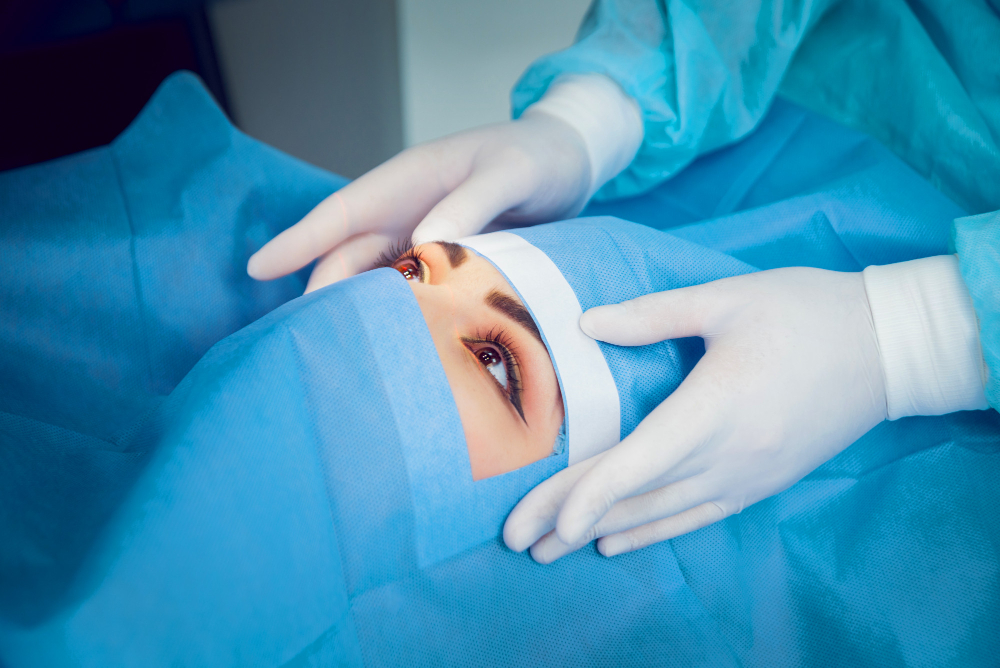LASIK surgery has helped more than 16 million US patients since its approval in the mid-1990s. Laser eye surgery shows impressive success rates, with some clinics reporting 100% success for correcting short-sightedness. Yet patients often ask questions about wearing contact lenses after their LASIK procedure.
Laser eye surgery wants to reduce or eliminate your need for vision correction. You might still need to wear contact lenses afterward in certain situations. Soft contact lenses become an option about six months after your LASIK procedure. The process can be complex because LASIK changes your corneal surface during surgery, which makes fitting contact lenses particularly challenging.
Understanding post-LASIK contact lens use helps protect your eye health and vision. This piece guides you through everything you need to know about wearing contact lenses after LASIK surgery, regardless of where you are in your treatment journey.

When Can You Wear Contact Lenses After LASIK?
Getting back to wearing contact lenses after LASIK takes patience. Your eyes go through major changes and need proper healing time before you can put contacts in again.
Typical healing timeline post-surgery
Most patients bounce back quickly after LASIK. You’ll notice better vision almost right away, but your eyes need more time to heal fully. Medical experts say your eyes usually take 2-3 months to heal completely after LASIK surgery. Your cornea adapts to its new shape during this time, and your vision becomes more stable.
Here’s how the healing usually works:
- First 24 hours: Swelling goes down, and blurry vision starts clearing up
- First week: Simple healing happens, and vision gets better
- 1-3 months: Vision becomes more stable
- 3-6 months: Most patients reach full stability
Different doctors have different views on when you can wear contacts again. Some eye specialists say you should wait at least one month. Others suggest 2-4 weeks or up to six months before you think over wearing contacts.
Why waiting is important for eye health
Putting contacts in too early could mess with your cornea’s healing. LASIK changes your cornea’s shape, which needs time to settle before fitting any contact lenses. While you recover, you might notice:
- Vision changes as your cornea heals
- Your eyes feel dry and need drops
- Light bothers you and causes mild discomfort
Putting a contact lens on a healing cornea might cause irritation, discomfort, or infection. Your old contact prescription won’t work anymore because your cornea’s shape has changed.
Signs your eyes are ready for lenses
Look for these good signs before trying contacts again:
- Your vision stays the same through two eye checkups in a row
- Your eyes aren’t as dry or sensitive anymore
- Your eye doctor confirms complete healing after a full exam
- Your eye surgeon gives you the green light to wear contacts
Always check with your eye doctor first. They’ll check how well you’ve healed and give you tailored advice about wearing contacts.
Why You Might Still Need Contact Lenses
People might need contact lenses even after a soaring win with LASIK surgery. Let’s look at what you can expect about your vision needs after the procedure.

Mild residual refractive errors
LASIK delivers excellent results most of the time, but perfect vision isn’t guaranteed for everyone. Studies show that over 95% of patients achieve satisfactory results, but some people still have leftover vision issues. These small vision imperfections happen because:
- The surgery under-corrects your original prescription
- Your eyes drift back toward their pre-surgery vision
- Your healing creates new tissue that affects how clearly you see
Contact lenses work great in these cases to get the best vision without needing more surgery. They help fix small amounts of remaining nearsightedness or astigmatism, especially if your cornea’s too thin to try another procedure.
Age-related vision changes like presbyopia
LASIK fixes distance vision but can’t stop natural ageing changes in your eyes. Presbyopia—the gradual loss of your eye’s ability to focus on nearby objects—shows up around age 40 and affects everyone at some point. You might need reading glasses or special contact lenses to see things up close if you’re in this age group. Your options include:
- Multifocal contact lenses that work for both near and far vision
- Monovision contacts where each eye focuses differently
Cosmetic or lifestyle priorities
Some people wear contact lenses after LASIK just to change their look. Coloured contacts can change or improve your eye’s appearance. The sort of thing you need to know is that:
- LASIK changes your cornea’s front curve
- Not all lenses fit post-LASIK eyes well
- You need professional fitting to keep your eyes healthy
Some jobs or activities need special contact lenses that do more than what LASIK provides alone. Whatever your reasons for wanting contacts after LASIK, getting them fitted by an experienced specialist is vital to your comfort and eye health.
Types of Contact Lenses Suitable After LASIK
Choosing the right contact lenses after LASIK needs careful thought about what works best for you. Your cornea’s new shape after surgery means you can’t use just any type of lens to correct your vision properly.

Soft lenses for minor corrections
Soft contact lenses might work if you need minor vision corrections after LASIK. These lenses work best for patients with anisometropia (vision difference between eyes) or those needing small vision adjustments. All the same, they don’t always deliver – research shows only 10-25% of patients get good results with soft lenses when they need vision correction after LASIK.
Rigid gas permeable (RGP) lenses
RGP lenses stand out as the best choice for post-LASIK vision correction. These rigid lenses keep their shape on your eye and create a tear “lake” between the lens and cornea that smooths out any surface irregularities.
RGP lenses give you:
- Excellent correction of both regular and irregular astigmatism
- High oxygen permeability that keeps your cornea healthy
- Better visual acuity than soft lenses
Larger diameter RGPs (11mm or greater) give the best results by staying stable and centred.
Hybrid and scleral lenses for complex cases
Hybrid lenses blend RGP lens vision quality with soft lens comfort. They feature a rigid centre and soft lens edges – a perfect match for post-LASIK corneas. Scleral lenses shine in handling complex post-LASIK problems. These larger lenses arch over your cornea and rest on the sclera (white part of your eye). The fluid reservoir they create bathes your cornea, which helps especially when you have dry eyes after surgery. These lenses never touch your cornea, so they won’t change its shape when you take them out.
Coloured or cosmetic lenses considerations
Looking into coloured contacts after LASIK? You should wait 2-3 months after surgery before trying them. Even for cosmetic use, you need professional fitting since LASIK changes your cornea’s curve.
Need vision correction after LASIK—or want contacts for special occasions? Let the experts at Precision Vision London guide you. Book your consultation today for safe, informed next steps.
Note that coloured lenses, especially those not made for post-surgical eyes, might not let enough oxygen through. That’s why high-quality lenses with proper fitting are vital to keep your eyes healthy after surgery.
Fitting and Safety Considerations
Wearing contact lenses after LASIK needs you to understand how the surgery changes your eyes. The fitting process is quite different from standard contact lens fitting. You need specialised expertise to ensure both comfort and vision correction.
How LASIK changes corneal shape
LASIK surgery changes your corneal topography. Normal eyes have a prolate shape (steeper in the centre, flatter at the periphery). Post-LASIK corneas become oblate—flatter centrally with a relatively steep periphery. This happens when the surgeon removes microscopic amounts of tissue from the cornea. Myopia corrections make the central region substantially flatter. Hyperopic corrections lead to central steepening. These changes affect how contact lenses sit on your eye and interact with the tear film.
Why personalised fitting is vital
The dramatic corneal changes make standard contact lens fitting approaches inadequate. Post-LASIK patients usually need more diagnostic lenses during fittings. They need almost double the number of office visits to achieve proper fit. Specialists use computerised instruments like corneal topographers to get highly accurate, point-to-point measurements of your post-surgery corneal surface. This precise mapping helps them select appropriate lens designs that match your unique corneal profile.
Managing dry eyes and comfort
Dry eye syndrome affects 95% of post-LASIK patients at first. The procedure can damage corneal nerves, which reduces sensitivity and affects tear production. Here’s how to improve comfort when wearing contacts:
- Use preservative-free lubricating drops
- Try specialty hydrophilic lenses that attract moisture
- Wait until dryness improves before attempting lens wear
- Keep yourself hydrated and think about omega-3 supplements
Importance of regular check-ups
Regular eye examinations play a vital role even after successful LASIK. These visits help specialists monitor your corneal health, spot potential complications early, and adjust contact lens prescriptions when needed. Experts suggest examinations one day, one week, one month, and three months after surgery, followed by yearly check-ups.
Do you still need vision correction after LASIK—or want contacts for special occasions? The experts at Precision Vision London can give you personalised guidance. Book your consultation today for safe, informed next steps.
Conclusion
Wearing contact lenses after LASIK surgery needs patience and professional guidance. LASIK surgery wants to reduce or eliminate your need for vision correction. Some situations might still require you to wear contact lenses afterward. Understanding the right time and method to safely start wearing contacts again plays a vital role in your long-term eye health. Your cornea needs proper time to heal—usually six months—before you can wear contacts again. Your eye shape becomes stable and dryness reduces during this time. These conditions make lens wear more comfortable. Quick returns to contact lenses could affect your surgical results and eye comfort negatively.
Post-LASIK contact lens fitting is different by a lot from standard fittings. Your changed corneal topography needs specialised expertise and advanced mapping technology to select the right lenses. Many patients get better results with hybrid or scleral lenses that fit their unique post-surgical corneal profile instead of regular soft lenses.
Precision Vision London provides expert guidance for safe, effective solutions if you need contacts for leftover refractive errors, age-related presbyopia, or cosmetic reasons. Our specialists know the complexities of post-LASIK eyes and create care plans that match your specific needs. Clear vision sometimes needs more work after LASIK surgery. Regular check-ups help monitor your corneal health and address vision changes quickly. Professional support and proper care let you safely use contact lenses after laser eye surgery when needed.
Key Takeaways
Understanding when and how to safely wear contact lenses after LASIK surgery is crucial for maintaining optimal eye health and vision correction.
- Wait at least 6 months after LASIK before wearing contacts to allow complete corneal healing and vision stabilisation
- LASIK changes your corneal shape from prolate to oblate, requiring specialised fitting with advanced mapping technology
- Rigid gas permeable (RGP) and scleral lenses typically work better than soft lenses for post-LASIK vision correction
- Up to 95% of patients experience dry eyes initially after LASIK, which must resolve before comfortable contact lens wear
- Professional fitting by specialists experienced with post-surgical eyes is essential due to altered corneal topography
Even successful LASIK patients may need contacts for residual refractive errors, presbyopia, or cosmetic preferences. Regular eye examinations remain vital for monitoring corneal health and adjusting prescriptions as your eyes continue to adapt post-surgery.
FAQs
Q1. How long should I wait before wearing contact lenses after LASIK surgery? It’s generally recommended to wait at least six months after LASIK surgery before wearing contact lenses. This allows sufficient time for your cornea to heal and your vision to stabilise. However, always consult your eye surgeon for personalised advice based on your specific recovery progress.
Q2. Can I wear coloured contact lenses for cosmetic purposes after LASIK? Yes, you can wear coloured contact lenses after LASIK, but it’s crucial to wait until your eyes have fully healed. Typically, this is about 2-3 months post-surgery. Ensure you get a professional fitting, as LASIK alters your corneal shape, affecting how lenses fit.
Q3. Are there special considerations for wearing contacts years after LASIK? Even years after LASIK, wearing contacts requires careful consideration. Your corneal shape has been permanently altered, so you’ll need specialised fitting. Regular check-ups are essential to monitor your eye health and ensure the lenses continue to fit properly as your eyes may change over time.
Q4. What types of contact lenses are best suited for post-LASIK eyes? Rigid gas permeable (RGP) lenses are often considered the best option for post-LASIK vision correction. Scleral lenses and hybrid lenses can also be effective, especially for complex cases. Soft lenses may work for minor corrections, but their success rate is lower in post-LASIK eyes.
Q5. How does LASIK affect future contact lens wear? LASIK changes your corneal shape from prolate to oblate, which affects how contact lenses fit and interact with your eye. This means you’ll need specialised fitting with advanced mapping technology. Additionally, many post-LASIK patients experience dry eyes initially, which can impact comfort when wearing contacts. Professional fitting by an experienced specialist is crucial for safe and comfortable lens wear after LASIK.
Authors & Reviewer
-
 Olivia: Author
Olivia: AuthorHi, I'm Olivia, a passionate writer specialising in eye care, vision health, and the latest advancements in optometry. I strive to craft informative and engaging articles that help readers make informed decisions about their eye health. With a keen eye for detail and a commitment to delivering accurate, research-backed content, I aim to educate and inspire through every piece I write.
-
 Dr. CT Pillai: Reviewer
Dr. CT Pillai: ReviewerDr. CT Pillai is a globally recognised ophthalmologist with over 30 years of experience, specialising in refractive surgery and general ophthalmology. Renowned for performing over 50,000 successful laser procedures.

